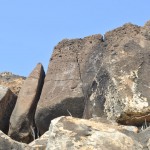Chaminade’s Academic Achievement Program students gained an insight of Hawaiian history and culture as they toured West Oahu with Blaise Baldonado, the AAP event coordinator and program advisor, on a cultural tour.

On Jan. 26, after an hour drive from Chaminade University, the group visited four locations.
“It’s always an opportunity for us to introduce a new perspective,” Baldonado said. “With this one [cultural tour] in particular, it was not only to see the west side of the island, but kind of just introduce them to kind of the more spiritual sites on the island. A lot of the places we went to were very spiritual. … I think it’s fairly important for, regardless of where you come from, if you’re living in the place, to understand the history of the place and understand the host culture and what the heritage is that’s a part of the land.”
The first site was Kaneana Cave. Baldonado, who acted as the student’s unofficial tour guide, said that Kaneana Cave is estimated up to be about 150,000 years old and was once underwater. Originally a huge lava tube, the erosion from the sea formed a cave. The different layers of erosion could be seen on the walls. The cave is 450 feet deep, and inside, remnants of the lava tube are still there.
Kaneana Cave has two legends. One legend says human kind was born from Kaneana Cave. According to this legend, the name Kaneana came from the god of creation, Kane. The second legend tells of a shape shifter who could turn himself human and shark. The shape shifter married a human and had a son whom discovered the taste of human flesh. After that discovery, the son would shift into a human, lure other humans, drag them into the cave, and eat them whenever he was hungry.
After exploring the cave, the group of students was brought to Mauna Lahilahi. Mauna Lahilahi is located south of Makaha on a peninsula. “Lahilahi” means “thin mountain” in Hawaiian. On “thin mountain,” the AAP students saw petroglyphs on rocks as they climbed up. In the past, Mauna Lahilahi served as a lookout point because it gave a great view of the ocean. Today, it is a pre-dominate fisherman training ground.
The third location was Pokai Bay. Pokai Bay is located on Kaneilio Point in Waianae. It is another fisherman training ground. In the past, ancient Hawaiians would fish in the bay on their canoes. Pokai Bay is believed to be protected by a Hawaiian dog god. The dog god kept travelers safe.
The final location that the AAP group visited was Kukaniloko Birthing Stones, a sacred site to the

Hawaiians. In ancient times, the wives of Aliis, chiefs or those of noble blood, would give birth to their child on a stone of the birthing stone grounds. Each stone seen in that land belonged to a different woman. People in the Alii’s district brought in the stone. Baldanado strictly told the students not to touch the rocks in any way.
Prior to this cultural tour, almost all the students there had never been to the West side of Oahu before. There were those who have been to some of the areas visited like Waianae or Wahiawa, but none of the students have ever been any of the sacred sites Baldonado brought them.
Many of the students, when asked which location they liked the most, chose the birthing stone.
“I think the place I enjoy was the birthing place,” said Yun Gervin, a junior who’s majoring in nursing. “As a nursing major, it’s really … feel the difference how ancient people give birth versus modern.”
Motusaga Vaeoso, a senior majoring in biology, said she was amazed. The birthing stone was not only a place of birth; it was also a place of celebration for the newborn child.
“In our culture [America Samoa], we don’t have such a place like that. To have a place like that … to celebrate the beginning of life. It’s quite amazing”
One student was not allowed to enter the holy grounds. According to tradition, women who are menstruating cannot enter. Back in ancient Hawaii, a woman’s period was not considered “pure.”
Baldonado chose these locations based on his experience with taking his friends on the same tour. He said it went well with his friends, so he figured it would be good for his students as well. Not many people go to west side of the island because of the stigma it has. People consider West Oahu dangerous and tend to avoid going there. Many Chaminade’s students live on campus or in town, so it’s also a long drive. He figured not many people go to that side of the island, and as a result, not many people are aware of the sacred sites.
“It is out of respect for history,” Baldonado said. “It’s important to uphold the traditions of the people who were here before us.”